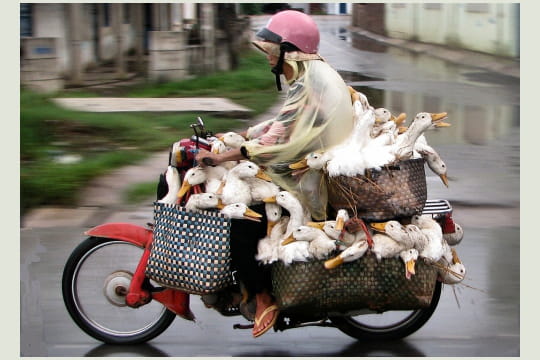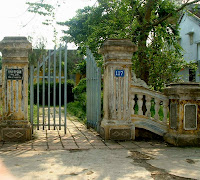Hue City was built in the very early 1800's alongside the banks of the Perfume River (Huong Giang). The architecture combines the influence of French military architect Vauban, often referred to as Louis XIV’s architect, and Oriental/Chinese palatial structures. There are several layers of the city one must cross in order to reach Tu Cam Thanh , or the Forbidden Purple City. The outermost boundary is called the "Defensive Fort", and has all of 10 gates. Hoang Thanh, on the Imperial Enclosure, is the second fortification around the city, and has 4 gates. Finally, one reaches the heart of the royal complex which is where the dynasty lived with their families, isolated from the rest of the world.
Now remember that we are being wheeled around by two Viet Namese cyclo drivers, who just took us to visit one of the Imperial Heritage Houses , which we felt was time very well spent. Now, we are very eager to see what we came for, and though it's mid afternoon, the sun is still very hot. It's very unfortunate that we find ourselves in front of the wrong gate, and I can see how they constructed this fortress to make access difficult. Though it is not the entrance, I can't help but admire the joy of the colors. It is definitely different from all other gates I have seen anywhere, with bright blue hues and splashy yellows and reds.
One of the many gates of the Imperial City, though not the entrance
As we begin to make a U turn, I sense we are finally going in the right direction. I don't think we could have done this by walking. In fact, I urge anyone who is coming to Hue to ensure transportation because it's a huge distance, and the heat is unbearable. We are getting closer to the entrance, which is the Ngo Mon Gate, and this time, it's unmistakable. You are in the right place. You will purchase your tickets at a modest looking table and chair "booth". The cost is approximately US$3.50, where you'll see more treasures for your money than MOMA will ever give you. On the reverse side of the ticket is an inscription by a UNESCO official:
stunning workmanship
"The cultural heritage and the natural heritage are among the priceless and irreplaceable possessions, not only of each nation, but of mankind as a whole. The loss, through deterioration or disappearance, of any of these most priced (sic) possessions constitutes an impoverishment of the heritage of all the peoples in the world. Hue must be saved for Vietnam, as one of the shrine (sic) of its cultural identity and for the rest of the world, as an integral part of the indivisible heritage of mankind"Take time to admire the gate in all its splendor and workmanship. The Ngo Mon gate is in the form of a phoenix swooping down with his wings spread. It is an impressive and beautiful sight.
Though I have never been to China's Forbidden City, I can immediately sense the tremendous influence it had on the architecture of this structure. UNESCO has put together a brief video of the capital city which is worthwhile. See it here .
angle view of the Ngo Mon gate
There is something very soothing about watching the moat with its lily pads and its hundred of koi fish. Of course, this is meant as yet another rampart between the visitor and the heart of the Imperial City. It is kept clean and free from algae, unlike some other waters which we had seen surrounding a pagoda. I'll be taking you there shortly.
There are actually two moats which protect the city; I recall looking onto one from one of the vast open chambers which are mostly emptied of furnishings. In the Palace building, one cannot enter or see the original throne room; it was recreated for tourists and looks quite tacky actually. I didn't care for it. The building itself seems to have withstood two wars and is in fairly good shape. The Hall of the Mandarins is vibrant with polished woods with subtle gilded decorations on the 80 carved columns which support its ornate timber roof.
Thai Hoa Palace
Thai Hoa Palace translates into "palace of supreme peace". The palace was used for most official functions like ceremonies and coronations. It was moved in 1833 from its former site on the grounds to where it stands now, 30 years after its completion. We will next take a slow walk around the grounds.












